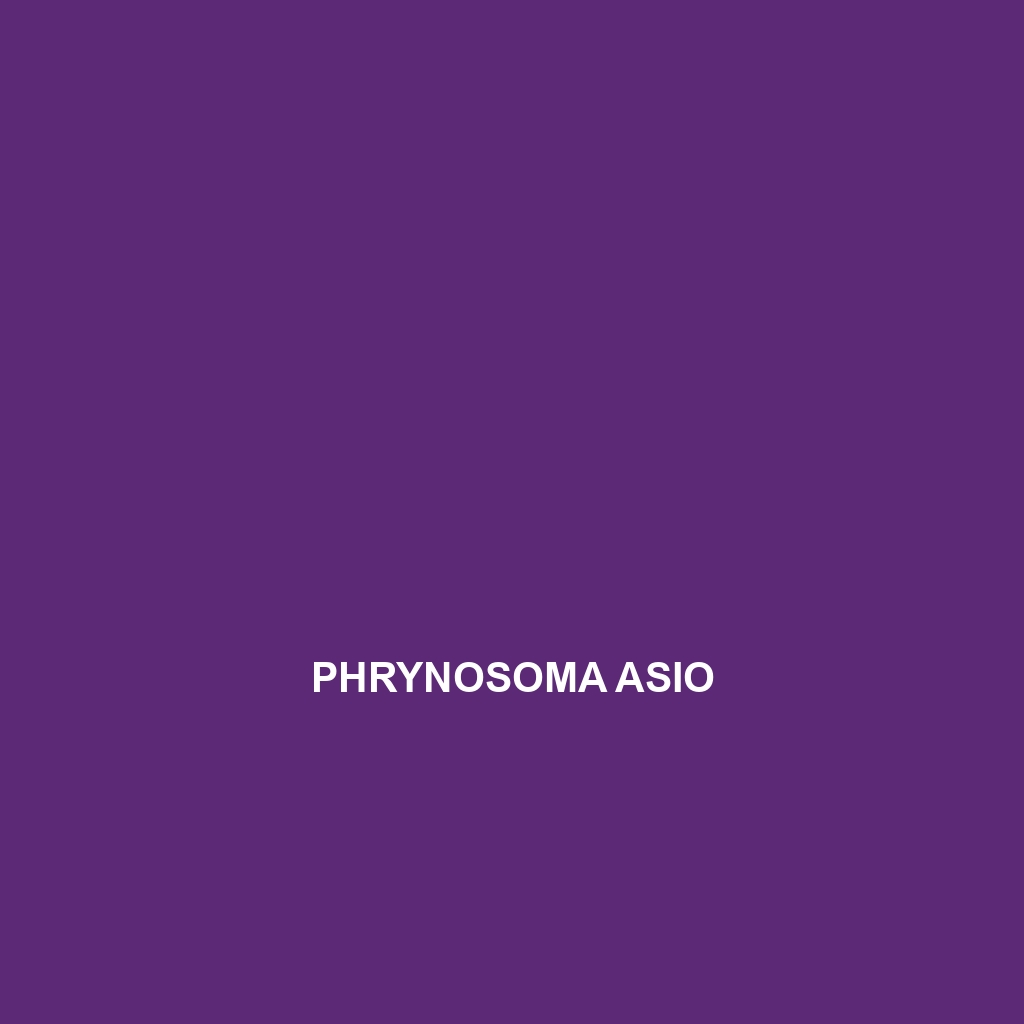Common Name
Phrynosoma asio
Scientific Name
Phrynosoma asio
Habitat
Phrynosoma asio, commonly known as the Arizona horned lizard, primarily inhabits arid and semi-arid regions of the southwestern United States and northwestern Mexico. This species is typically found in various environments including deserts and grasslands, where it prefers sandy or loose soil types. The climate in these regions can be extreme, with intense sun exposure and minimal rainfall making them unique ecosystems. The Arizona horned lizard often seeks shelter under rocks, shrubs, or vegetation, which provides it with both cover from predators and a cooler microhabitat. Some common geographical locations include the Sonoran Desert and areas with sparse forests, where the interplay of sun and shade creates ideal living conditions.
Physical Characteristics
The Arizona horned lizard is a unique reptile, measuring approximately 3 to 5 inches in length. Its body is flattened and oval-shaped, providing an efficient aerodynamic profile for its lifestyle. The most striking feature of Phrynosoma asio is its spiky body adorned with characteristic horn-like projections on its head, giving it a distinct appearance that aids in defense against predators. The coloration of this species is usually a mix of browns and tans, allowing it to blend seamlessly into its surrounding habitat to evade detection. Their skin texture is rough, further enhancing their camouflage. Overall, the physical characteristics of Phrynosoma asio make it an excellent example of adaptation to its environment and efficient evasion of both predators and environmental threats.
Behavior
Behaviorally, Phrynosoma asio exhibits a variety of fascinating traits. Primarily diurnal, these lizards are active during the daytime, basking in the sun to regulate their body temperatures. Social interactions among horned lizards can be observed during the mating season, where males engage in head-bobbing displays to attract females, showing a level of complex communication. Additionally, this species utilizes unique behavior to evade threats; it can flatten its body against the ground or hide among leaf litter. Interestingly, when threatened, Phrynosoma asio can expel a small amount of blood from its eyes, a defense mechanism intended to startle predators. These behaviors highlight the lizard’s adaptation to its surroundings and its strategies for survival.
Diet
Phrynosoma asio is primarily insectivorous, with a diet heavily consisting of ants and various small insects. Occasionally, they may consume other arthropods or occasional plant matter, which classifies them as opportunistic feeders. Their feeding pattern includes ambush techniques, where they remain still and wait for insects to come within striking distance. This method reduces energy expenditure and allows them to thrive in their sparse environments. The diet of Phrynosoma asio plays an important ecological role by controlling insect populations, emphasizing its importance in the food web.
Reproduction
The reproductive cycle of Phrynosoma asio typically begins in the spring, with mating taking place as temperatures rise. After a gestation period of about 2 to 3 months, females lay clutches of 10 to 30 eggs in sandy soil, often hidden to protect them from predators. The hatchlings emerge in late summer to early fall, typically measuring 1 to 2 inches long. Parental care is minimal, as the young are independent from the moment of hatching. This reproductive strategy allows for a rapid increase in population numbers during favorable environmental conditions, although it also leaves hatchlings vulnerable to predation and environmental challenges.
Conservation Status
According to the International Union for Conservation of Nature (IUCN), Phrynosoma asio is currently classified as a species of ‘Least Concern’, indicating that it does not face immediate threats of extinction. However, habitat loss due to urban development and agricultural expansion poses significant challenges to their populations. Conservation efforts are important in ensuring that their natural habitats remain intact, as well as establishing protected areas to safeguard their living environments. Engaging local communities in habitat preservation initiatives can make a significant difference in conserving this unique species.
Interesting Facts
One of the most interesting facts about Phrynosoma asio is its remarkable ability to change colors with its surroundings, which enhances its camouflage and helps protect it from predators. They are also known for their interesting predatory evasion tactic of using their flattened body to blend into sandy terrain, which makes them difficult to spot. Furthermore, horned lizards are a part of cultural folklore in some Native American tribes, signifying their role in the regional biodiversity and community history.
Role in Ecosystem
Phrynosoma asio plays a crucial role in the ecosystem by acting as both predator and prey. As insectivores, they help control insect populations, serving as a natural pest management tool. Additionally, they are a food source for various larger predators, including birds of prey and mammals, contributing to the food web’s stability. Their presence indicates healthy ecosystem dynamics, as they rely on various plant and animal interactions to thrive. By understanding their ecological role, conservationists can prioritize efforts to preserve not only the horned lizard but also the ecosystems they inhabit.
